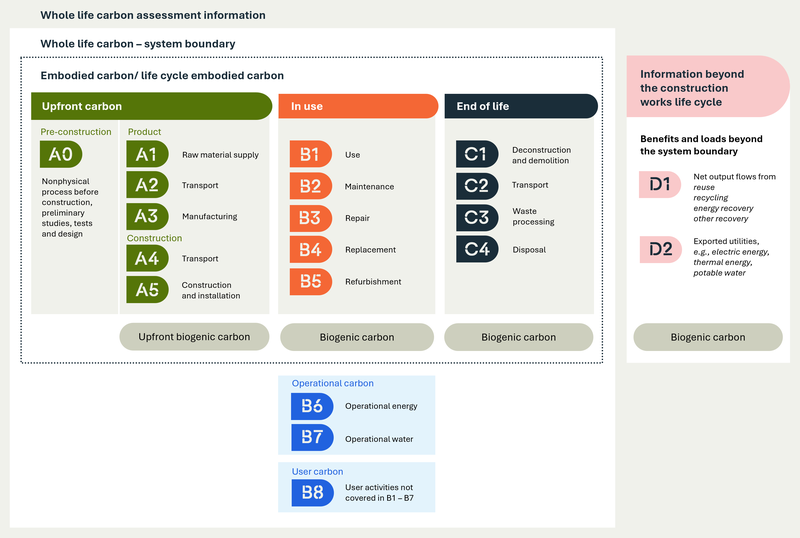Understanding the RICS whole life carbon assessment standard

Overview
In the world of construction, measuring the environmental impact of our properties and infrastructures have become increasingly crucial. But what exactly should we measure to understand our carbon footprint fully?
That’s where The Royal Institution of Chartered Surveyors (RICS) and their Whole Life Carbon Assessment (WLCA) standard comes in. First introduced in 2017 and updated it in November 2023, WLCA is set to become the world-leading standard for consistent and accurate carbon measurement in the built environment.
This article will walk you through what exactly is WLCA and why is it important for those in the building industry to pay attention to it.
What is the RICS whole life carbon assessment (WLCA)?
The RICS WLCA is a method for measuring carbon emissions of building and infrastructure projects throughout their entire lifespan.
It sets the bar for how we estimate the amount of carbon emitted by construction projects, from the early stage of development planning to the end of its useful life. Its main aim is to ensure that the data we collect on carbon emissions is consistent, accurate, and comparable across different projects and asset types.
What does the RICS whole life carbon assessment (WLCA) cover?

Source: RICS whole life carbon assessment for the built environment, building and infrastructure life cycle stages and information modules (adapted from EN 15978, EN 17472 and EN 15643, with additions to illustrate biogenic carbon).
The whole life carbon assessment breaks down into 4 key life cycle stages:
- Upfront carbon (A): Encompasses all carbon emissions and removals resulting from activities essential for completing the construction of the asset.
- In use carbon (B): Encompasses all carbon emissions and removals occurring during the operational or in-use stage of the asset.
- End of life carbon (C): Encompasses all impacts associated with the ‘end-of-life,’ including deconstruction or demolition, waste processing, recovery or disposal, and the related transportation.
- Beyond the construction works life cycle (D): Encompasses potential benefits and loads that extend beyond the system boundary.
It’s important to note that WLCA doesn’t include certain factors like carbon offsets, temporary carbon storage or permanent biogenic carbon storage as part of the calculation at product or asset level.
What are the recent changes to the 2nd edition of RICS whole life carbon assessment (WLCA)?
General changes:
- The whole life carbon standard application is extended to include all types of built assets and infrastructure projects.
- Alignment with the International Cost Management Standards (ICMS) 3rd Edition and the Built Environment Carbon Database (BECD).
- Provides additional guidance on biogenic carbon, retrofit and alignment with circular economy.
- Requirement for contingency allowance to address uncertainty at early stage.
Introduction of new reporting stages as follows:
- A0 preconstruction stage, covering surveys and activities associated with design
- B8 covering emissions from employee commute and vehicles using a road.
- Module D refined to include D1 and D2 to assess carbon load and benefits beyond the system boundaries for materials (e.g. material reuse) and utilities respectively (e.g. generated electricity)
How will this impact the industry?
The arrival of the 2nd edition of RICS WLCA represents a significant step forward for the building industry’s approach to environmental sustainability. It addresses the industry’s challenge of lacking a universal carbon measure, where multiple standards exist with varying parameters for inclusion and exclusion in assessments.
Due to its comprehensive nature and applicability across asset types, RICS WLCA sets the bar for measuring carbon emissions in construction projects. We anticipate that this will shape future standards, methodologies, and sustainability frameworks globally.
TSA Riley has long respected the thoroughness of the RICS guidelines and refer to them when conducting carbon assessments.
As industry professionals, it’s crucial to broaden our perspectives during assessments, uncover hidden impacts, and explore practical low carbon solutions. Whether you’re an investor, developer, architect, engineer, or contractor, integrating WLCA into your practices promotes environmentally conscious decision-making and contributes to a greener planet.
Ready to take the next step towards a more sustainable future?
Start implementing WLCA in your projects today.
Get in touch to learn more about how you can integrate WLCA into your projects with our technology enabled carbon consultancy services.